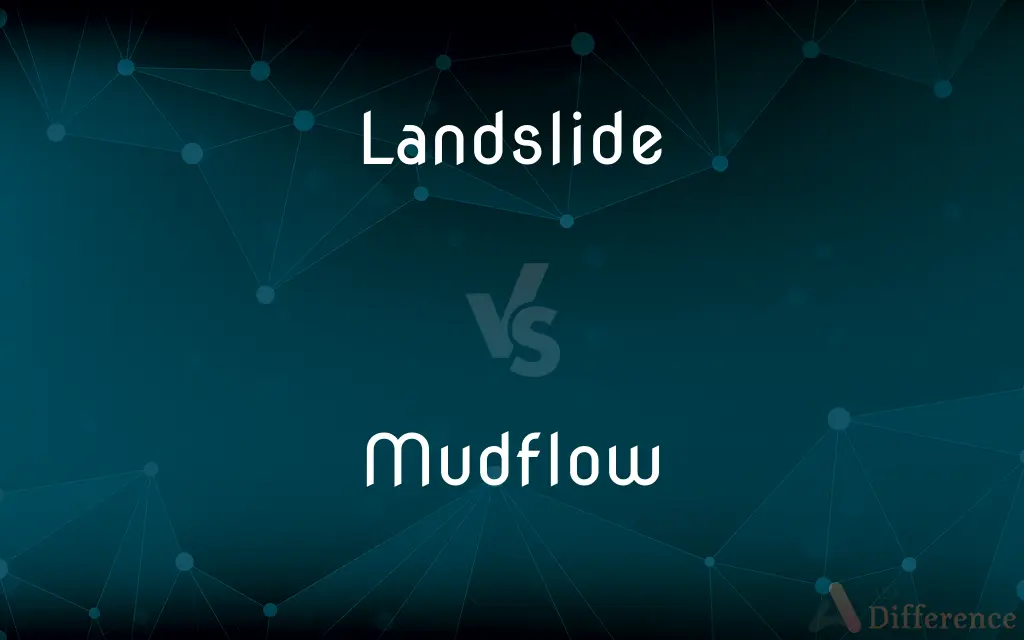Landslide vs. Mudflow — What's the Difference?
By Maham Liaqat & Urooj Arif — Updated on May 9, 2024
A landslide is the movement of rock, soil, or debris down a slope due to gravity, while a mudflow is a rapid flow of water-saturated soil and debris, often triggered by heavy rainfall or volcanic activity.

Difference Between Landslide and Mudflow
Table of Contents
ADVERTISEMENT
Key Differences
A landslide describes any downward movement of earth materials like rock, soil, or debris due to gravitational forces. A mudflow, on the other hand, is a type of landslide involving the fast flow of water-laden soil, often containing a mixture of fine particles, sand, and debris.
Landslides occur when the slope's stability is compromised, often due to erosion, earthquakes, or human activities. Mudflows typically occur when heavy rainfall or rapid snowmelt saturates the soil, creating a slurry that rushes downhill.
Landslides can vary in speed from slow creeping movements to sudden and destructive falls, while mudflows tend to be fast-moving due to their high water content.
Landslides are more general and can involve dry or wet materials, whereas mudflows specifically refer to very fluid, fast-moving masses.
Comparison Chart
Composition
Rock, soil, debris
Water-saturated soil and debris
ADVERTISEMENT
Trigger
Gravity, erosion, earthquakes
Heavy rain, volcanic activity, snowmelt
Speed
Slow creep to rapid fall
Rapid flow
Water Content
Varies from low to high
High
Impact
Disruption to infrastructure, property damage
Flooding, severe property damage
Compare with Definitions
Landslide
Downward movement of rock, soil, or debris due to gravity.
The landslide caused significant damage to the hillside community.
Mudflow
Rapid flow of water-saturated soil and debris.
The mudflow carried large amounts of debris downhill after the storm.
Landslide
Triggered by earthquakes, erosion, or construction.
The landslide occurred after a series of earthquakes shook the region.
Mudflow
Triggered by intense rainfall, snowmelt, or volcanic activity.
The volcanic eruption resulted in a destructive mudflow in nearby villages.
Landslide
Varies in speed from gradual creep to sudden falls.
A slow landslide gradually pushed fences and structures out of place.
Mudflow
Typically involves a mix of mud, silt, sand, and debris.
The mudflow covered the area in a thick layer of mud and stones.
Landslide
Disrupts infrastructure, transportation, and habitats.
Landslides can block roads, cut off communities, and harm wildlife.
Mudflow
Often follows stream channels or natural drainage paths.
The mudflow followed the valley's natural stream channels, damaging bridges.
Landslide
Common in areas with steep slopes or loose soil.
The mountain slopes were prone to landslides after heavy deforestation.
Mudflow
Can travel long distances at high speeds.
The mudflow reached the riverbank within minutes of starting.
Landslide
The term landslide or, less frequently, landslip, refers to several forms of mass wasting that may include a wide range of ground movements, such as rockfalls, deep-seated slope failures, mudflows, and debris flows. Landslides occur in a variety of environments, characterized by either steep or gentle slope gradients, from mountain ranges to coastal cliffs or even underwater, in which case they are called submarine landslides.
Mudflow
A mudflow or mud flow is a form of mass wasting involving "very rapid to extremely rapid surging flow" of debris that has become partially or fully liquified by the addition of significant amounts of water to the source material.Mudflows contain a significant proportion of clay, which makes them more fluid than debris flows; thus, they are able to travel farther and across lower slope angles. Both types are generally mixtures of various kinds of materials of different sizes, which are typically sorted by size upon deposition.Mudflows are often called mudslides, a term applied indiscriminately by the mass media to a variety of mass wasting events.
Landslide
The downward sliding of a relatively dry mass of earth and rock.
Mudflow
A fluid or hardened stream or avalanche of mud.
Landslide
The mass that slides. Also called landslip.
Mudflow
A flowing mass of soft, wet, unconsolidated earth and fine-grained debris, made fluid by rain or melted snow and often building up great speed.
Landslide
A percentage of votes greatly exceeding the required margin of victory.
Mudflow
The deposit resulting from such a flow.
Landslide
An election that sweeps a party or candidate into office.
Mudflow
A type of landslide characterized by large flows of mud and water.
Landslide
A great victory.
Mudflow
The dried-out product of such a flow.
Landslide
A natural disaster that involves the breakup and downhill flow of rock, mud, water and anything caught in the path.
Landslide
A vote won by a wide or overwhelming majority.
The candidate won by a landslide.
Landslide
To undergo a landslide.
Landslide
The slipping down of a mass of land from a mountain, hill, etc.
Landslide
The land which slips down.
Landslide
An election victory in which the winning candidate receives a substantial majority of the votes, usually meaning at least ten per cent more than any opposing candidate.
Landslide
Any overwhelming victory.
Landslide
An overwhelming electoral victory;
Roosevelt defeated Hoover in a landslide
Landslide
A slide of a large mass of dirt and rock down a mountain or cliff
Common Curiosities
Can landslides occur slowly over time?
Yes, landslides can happen gradually as soil creeps downhill, causing slow damage to structures.
What is the main difference between a landslide and a mudflow?
A landslide is a broader term for the downhill movement of rock and soil, while a mudflow specifically involves water-saturated soil and debris flowing quickly.
What role does vegetation play in preventing landslides?
Vegetation helps stabilize slopes by reinforcing the soil with roots and reducing surface erosion.
Can human activities increase landslide risks?
Yes, activities like deforestation, mining, and poor construction practices can destabilize slopes and increase landslide risks.
What usually triggers landslides?
Landslides are often triggered by gravity, earthquakes, erosion, or human activities like deforestation and construction.
How do mudflows affect communities?
Mudflows can flood areas, damage property, and destroy infrastructure due to their rapid movement and high water content.
What areas are most susceptible to mudflows?
Regions with steep terrain, loose soil, and high rainfall or volcanic activity are most prone to mudflows.
Are mudflows more dangerous than landslides?
Both can be dangerous, but mudflows tend to travel quickly and over longer distances due to their high water content.
Are mudflows and debris flows the same?
Debris flows are similar to mudflows but typically contain larger and more varied materials like boulders and logs.
What steps can reduce mudflow damage?
Building retaining walls, improving drainage, and avoiding construction in vulnerable areas can help reduce mudflow damage.
What is a lahar, and how is it related to mudflows?
A lahar is a volcanic mudflow composed of water, volcanic ash, and debris, often triggered by volcanic eruptions.
Can landslides be predicted?
While precise predictions are difficult, monitoring soil movement and rainfall patterns can help identify high-risk areas.
Why are steep slopes more prone to landslides?
Steep slopes have a higher gravitational pull on soil and rock, increasing the risk of downward movement.
What safety measures should be taken in landslide-prone areas?
Evacuate if warnings are issued, avoid steep slopes during heavy rain, and have an emergency plan for quick evacuation.
Do landslides occur only in mountainous regions?
No, landslides can also happen in coastal cliffs, river valleys, and areas with erodible soil.
Share Your Discovery

Previous Comparison
Odometer vs. Pedometer
Next Comparison
Biochron vs. BiozoneAuthor Spotlight
Written by
Maham LiaqatCo-written by
Urooj ArifUrooj is a skilled content writer at Ask Difference, known for her exceptional ability to simplify complex topics into engaging and informative content. With a passion for research and a flair for clear, concise writing, she consistently delivers articles that resonate with our diverse audience.












































